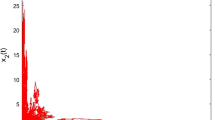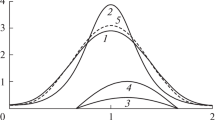Abstract
It is shown that the lottery competition model permits coexistence in a stochastic environment, but not in a constant environment. Conditions for coexistence and competitive exclusion are determined. Analysis of these conditions shows that the essential requirements for coexistence are overlapping generations and fluctuating birth rates which ensure that each species has periods when it is increasing. It is found that a species may persist provided only that it is favored sufficiently by the environment during favorable periods independently of the extent to which the other species is favored during its favorable periods.
Coexistence is defined in terms of the stochastic boundedness criterion for species persistence. Using the lottery model as an example this criterion is justified and compared with other persistence criteria. Properties of the stationary distribution of population density are determined for an interesting limiting case of the lottery model and these are related to stochastic boundedness. An attempt is then made to relate stochastic boundedness for infinite population models to the behavior of finite population models.
Similar content being viewed by others
References
Armstrong, R. A., McGehee, R.: Coexistence of species competing for shared resources. Theoret. Population Biology 9, 317–328 (1976)
Barbour, A. D.: Quasi-stationary distributions in Markov population processes. Adv. Appl. Probab. 8, 296–314 (1976)
Bartlett, M. S.: On theoretical models for competitive and predatory biological systems. Biometrika 44, 27–42 (1957)
Bartlett, M. S., Gower, J. C., Leslie, P. H.: A comparison of theoretical and empirical results for some stochastic population models. Biometrika 47, 1–11 (1960)
Beddington, J. R., Free, C. A., Lawton, J. H.: Concepts of stability and resilience in predator-prey models. J. Anim. Ecol. 45, 791–816 (1976)
Billingsley, P.: Convergence of probability measures. New York: Wiley 1968
Billingsley, P.: Weak convergence of measures. Philadelphia: SIAM 1971
Botkin, D. B., Sobel, M. J.: Stability in time-varying ecosystems. Am. Nat. 109, 625–646 (1975)
Breiman, L.: Probability. Menlo Park, CA: Addison-Wesley 1968
Chesson, P. L.: Predator-prey theory and variability. Ann. Rev. Ecol. Syst. 9, 323–347 (1978)
Chesson, P. L.: Models for spatially distributed populations: The effect of within-patch variability. Theoret. Population Biology 19, 288–325 (1981)
Chesson, P. L., Warner, R. R.: Environmental variability promotes coexistence in lottery competitive systems. Am. Nat. 117, 923–943 (1981)
Cushing, J. M.: Two species competition in a periodic environment. J. Math. Biol. 10, 385–400 (1980)
de Mottoni, P., Schiaffino, A.: Competition systems with periodic coefficients: A geometric approach. J. Math. Biol. 11, 319–335 (1981)
Feller, W.: An introduction to probability theory and its applications, Vol. II, second edition. New York: Wiley 1971
Goh, B. S.: Stability, vulnerability, and persistence of complex ecosystems. Ecological Modelling 1, 105–116 (1975)
Goh, B. S.: Nonvulnerability of ecosystems in unpredictable environments. Theoret. Population Biology 10, 83–95 (1976)
Heyde, C. C.: On the central limit theorem for stationary processes. Z. Wahrscheinlichkeitstheorie 30, 315–320 (1974)
Holling, C. S.: Resilience and stability of ecological systems. Ann. Rev. Ecol. Syst. 4, 1–23 (1973)
Ibragimov, I. A.: A note on the central limit theorem for dependent random variables. Theoret. Prob. Appl. 20, 135–141 (1975)
Karlin, S., Liberman, U.: Random temporal variation in selection intensities: Case of large population size—I. Theoret. Population Biology 6, 355–382 (1974)
Koch, A. L.: Coexistence resulting from an alternation of density independent and density dependent growth. J. Theoret. Biol. 44, 373–386 (1974)
Kurtz, T. G.: Solutions of ordinary differential equations as limits of pure jump Markov processes. J. Appl. Probab. 7, 49–58 (1970)
Leigh, E. G.: Population fluctuations, community stability, and environmental variability. In: (M. L. Cody, J. M. Diamond, eds.) Ecology and evolution of communities, pp. 51–73. Cambridge MA: Harvard University Press 1975
Leslie, P. H.: A stochastic model for studying the properties of certain biological systems by numerical methods. Biometrika 45, 16–31 (1958)
Leslie, P. H., Gower, J. C.: The properties of a stochastic model for two competing species. Biometrika 45, 316–330 (1958)
Leslie, P. H., Gower, J. G.: The properties of a stochastic model for the predator-prey type of interaction between two species. Biometrika 47, 219–234 (1960)
Levins, R.: Coexistence in a variable environment. Am. Nat. 114, 765–783 (1979)
Lewontin, R. C.: The meaning of stability. In: Diversity and stability in ecological systems. Brookhaven Symposium in Biology No. 22, 13–24 (1969)
Ludwig, D.: A singular perturbation problem in the theory of population extinction. Soc. Ind. Appl. Math.-Am. Math. Soc. Proc. 10, 87–104 (1976)
May, R. M.: Stability and complexity in model ecosystems, second edition. Princeton, N. J.: Princeton Univ. Press 1974
Norman, F.: An ergodic theorem for evolution in a random environment. J. Appl. Prob. 12, 661–672 (1975)
Revuz, D.: Markov chains. Amsterdam: North-Holland Publication Co. 1975
Sale, P. F.: Maintenance of high diversity in coral reef fish communities. Am. Nat. 111, 337–359 (1977)
Stewart, F. M., Levin, B. R.: Partitioning of resources and the outcome of interspecific competition: A model and some general considerations. Am. Nat. 107, 171–198 (1973)
Turelli, M.: Random environments and stochastic calculus. Theoret. Population Biology 12, 140–178 (1977)
Turelli, M.: A reexamination of stability in randomly fluctuating versus deterministic environments. Theoret. Population Biology 13, 244–267 (1978a)
Turelli, M.: Does environmental variability limit niche overlap? Proc. Natl. Acad. Sci. USA 75, 5065–5089 (1978b)
Turelli, M.: Niche overlap and invasion of competitors in random environments I. Models without demographic stochasticity. Theoret. Population Biology 20, 1–56 (1981)
Turelli, M., Gillespie, J. H.: Conditions for the existence of stationary densities for some two dimensional diffusion processes with applications in population biology. Theoret. Population Biology 17, 167–189 (1980)
Wang, F. J. S.: Limit theorems for age and density dependent stochastic population models. J. Math. Biol. 2, 373–400 (1975)
Author information
Authors and Affiliations
Rights and permissions
About this article
Cite this article
Chesson, P.L. The stabilizing effect of a random environment. J. Math. Biology 15, 1–36 (1982). https://doi.org/10.1007/BF00275786
Received:
Revised:
Issue Date:
DOI: https://doi.org/10.1007/BF00275786




